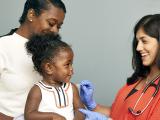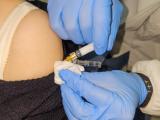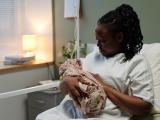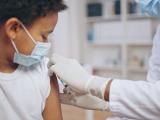Apr 19, 2010 (CIDRAP News) – Some reports released during the National Immunization Conference this week support the idea that school-based influenza vaccination programs are a workable way to get flu doses into the arms and noses of more school children faster.
More than 120,000 New York City children received pandemic H1N1 flu vaccine doses at school in the fall of 2009, and school-based immunization against H1N1 was practiced widely in Massachusetts as well, according to abstracts of studies being presented at the Atlanta conference.
New York City's experience
A report by Jane Zucker, MD, MSc, assistant commissioner for the New York City Department of Health and Mental Hygiene, says the vaccine was offered at more than 1,200 public and private elementary schools and at 58 weekend clinics for middle and high school students.
Of 1.4 million school-age children in all schools (K-12), 572,624 were eligible for immunization, according to Zucker. Parents signed vaccination consent forms for 150,469 children (26.3%). Of those, 120,233 received a first dose of vaccine, and 75,489 received a second dose.
Regular school nurses administered vaccine in small elementary schools, and contract nurses helped out in mid-size schools (400 to 600 students), the report says. Nine-person teams gave the doses in larger schools.
The elementary-school and upper-level immunization programs both took a lot of staff time, involving about 600 full-time and 3,500 weekend employees of the health department, 19 other city agencies, and volunteer groups.
The turnout at weekend clinics was low, Zucker reports. Schools that enjoyed active involvement by parent coordinators and principals were more likely to have good participation. To succeed, schools also had to invest in the infrastructure for vaccine storage and handling and for training.
"Citywide flu vaccination is feasible, though its cost-effectiveness as a strategy must be determined," the report concludes.
Massachusetts schools
In Massachusetts, the Department of Public Health (MDPH) began working to establish school-based vaccination after the Advisory Committee on Immunization Practices in 2008 recommended seasonal flu shots for all school-age children, according to a report by Mary Conant, RN, BSN, deputy program manager for the department's immunization program, and colleagues. The aim was to build the capacity to vaccinate all school children, since their regular healthcare providers, or "medical home," lacked the capacity.
Working with Northeastern University, the MDPH provided three regional training sessions on seasonal and H1N1 flu and 30 regional vaccine-administration refresher courses for school and public health nurses.
Starting in September, 88 school systems provided seasonal flu shots in schools, administering more than 57,000 doses, the report states. And by January of this year, 321 of the 351 cities and towns in Massachusetts had conducted H1N1 immunization clinics in schools, during or after school hours. But the report does not say how many doses were given or how many children were immunized.
"By providing education and training to school and public health nurses we were able to establish a viable option outside of the medical home to expand our capacity to vaccinate the school aged children with seasonal and 2009 H1N1 influenza vaccine," Conant and colleagues say.
Massachusetts is one of four New England states that were praised by the Centers for Disease Control and Prevention (CDC) earlier this month for doing an exceptional job of immunizing children against H1N1. Three of the four carried out school vaccination programs, as did 37 other states, said Dr. Anne Schuchat, head of the CDC's National Center for Immunization and Respiratory Diseases.
Pilot program in Rochester, N.Y.
In another report, a team from Rochester, N.Y., assessed the rates of parental consent in the first year of a pilot program to provide seasonal flu shots at school. Schools that enrolled in the program were randomly assigned to be a "high-intensity school" (HIS) or a "low intensity school" (LIS), referring to the number of reminders and consent forms sent to parents. Twelve urban and nine suburban schools enrolled.
In the HISs, 19% of students returned the consent forms, versus 15% in the LISs, says the report by Sharon Humiston, MD, MPH, and colleagues. But 16% of the consents in the HISs and 24% of those in the LISs were incomplete, requiring staff members to contact the families.
The authors conclude that the program "may have lessened the burden of vaccination on primary care offices." They add that automated telephone reminders, used at no extra cost in the HISs, may have improved parental response.
Zucker abstract
http://cdc.confex.com/cdc/nic2010/webprogram/Paper22855.html
Conant et al abstract
http://cdc.confex.com/cdc/nic2010/webprogram/Paper22720.html
Humiston et al abstract
http://cdc.confex.com/cdc/nic2010/webprogram/Paper22475.html
See also:
Apr 1 CIDRAP News story "CDC estimates 24% of Americans received H1N1 vaccine"


















